

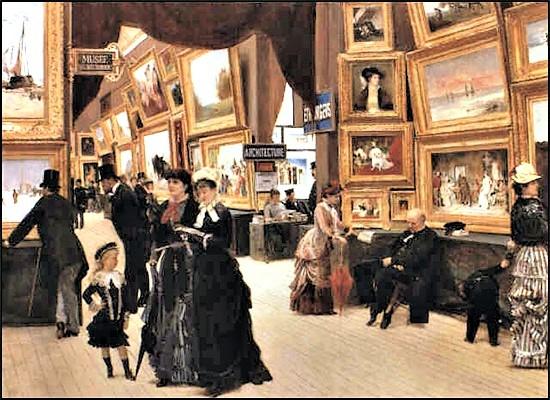
Over the course of his career as an artist on two continents Tommaso Juglaris exhibited regularly. In the early years when he resided in Turin, Juglaris’s paintings were shown at the Society for the Promotion of Fine Arts (Promotrice delle Belle Art) and at the Artists’ Circle of Turin (Circolo degli Artisti di Torino). During the decade he spent in the French capital, Juglaris turned to the famous Paris Salon to make his mark. It was regarded as the premier place to win attention and to build a reputation as an artist in the art capital of the world. As the artist Pierre-August Renoir sardonically observed to the dealer Durand-Ruel: “In Paris there are scarcely fifteen art-lovers able to appreciate a painter outside the Salon. And there are 80,000 who wouldn’t buy a picture of the nose on their face if it wasn’t painted by a Salon artist.”
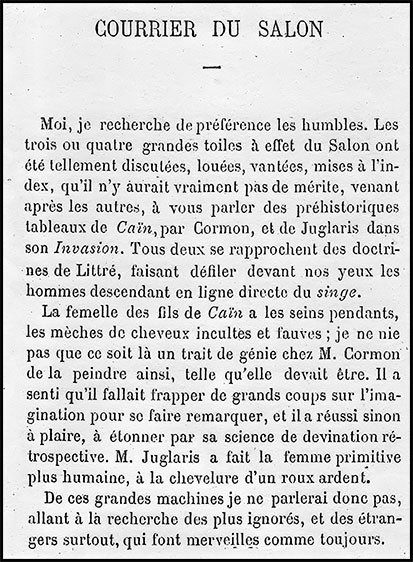
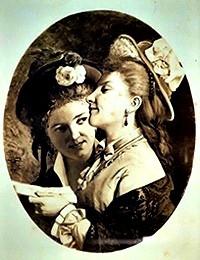
Although more lucrative industrial art consumed much of his talent, Juglaris—taking time off Thursdays through Sundays--was able through great diligence to complete and submit to the Paris Salon such paintings as The Confidence (1873), Offering to the God Lares (1874), and Paolo Veronese in Venice, also known as Venetian Promenade (1879). All three works found favor with the Salon’s art jury who not only approved them for exhibition but also awarded each an honorable mention. This cumulative triple honor earned Juglaris the classification of being “hors concours” or “outside the competition.” Consequently, in 1880 he was entitled to exhibit his next Salon painting, The Invasion without any advance qualifying jury review. It was one of 7,289 works displayed on the crowded walls of the Palais des Champs Elysees—the largest Salon exhibition ever. That was also the same year that the French considered barring Americans from further Award competition because, as art historian Stephen Birmingham notes, the number of the latter’s submissions seemed to be swamping the Salon.
In his memoir Juglaris recalls that his honored paintings did not immediately sell and were let go for a mere “pittance” when they did. Nevertheless, he adds, the commendations received from Salon jurors “enabled me to enter the category of France’s classified artists and with that title I could make interesting acquaintances from among the most eminent men of art and letters.” It is not known how many of Juglaris’s Salon paintings survive today in either Europe or America. However, photographs, preparatory sketches, and published descriptions at least preserve some semblance or idea of them.
Depicting two women of his own era sharing intimate news or gossip from a letter received, The Confidence demonstrated Juglaris’s gift for portraiture. Through up-close facial expressions he manages to capture the spirit of their moment together. Very differently, in Offering to the God Lares, Juglaris presents in profile a “life-sized” Roman matron paying tribute at a family shrine to a god variously worshipped in ancient Rome as a guardian of households, neighborhoods, and the Eternal City. Leaning forward to make her sacrifice, the matron wears a rippling, shimmering overskirt that reveals Juglaris’s talent for drawing supple “drapery” and clothing.
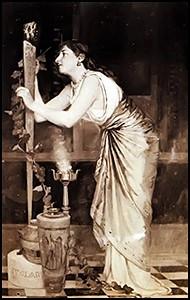
Also life-sized, Juglaris’s Venetian Promenade was a huge horizontal work. “Brave in Venetian colors” (to borrow the words of a subsequent Boston art critic), it depicts a festive, panoramic view of the great, late Renaissance painter traveling by gondola in grand style. The choice of subject seems to have reflected Juglaris’s personal admiration for Veronese, plus a hope to emulate him. Along with Titian and Tintoretto, Veronese had dominated Venetian painting during the sixteenth century. He favored large paintings of Biblical feasts and mythological scenes. Besides being a superb colorist, Veronese was famous for decorative art: he was Venice’s leading painter of ceilings. Unlike the paintings of many other artists which were “skyed” at the Paris Salon—hung so high on the Salon walls they could barely be seen—Venetian Promenade was, in Juglaris’s opinion, “well-exhibited.” It was also noticed. Both the Goupil and Brown art houses of Paris published photographs of the painting. Meanwhile, Juglaris prepared his own sketch of the painting which also reached print.
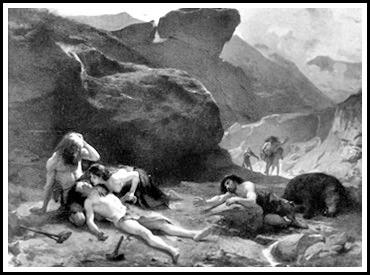
For The Invasion, his final Salon painting before departing for the United States, Juglaris may have taken some artistic inspiration from Andrea Gastaldi, his old teacher from the Accademia Albertina, who had earlier painted A Drama from a Prehistoric Epoch (1870). However, in his memoir Juglaris credits his choice of subject matter to his reading of a history of the Italian peninsula before the rise of the Roman Empire. Juglaris’s painting presents a prehistoric family crouching near the entrance of a cave, observing the distant approach of a Nordic barbarian horde. Taking note of The Invasion at the Salon, a French critic cited it favorably. “Juglaris,” he remarked, “has made the primitive woman most human, her hair a fiery red.” (“Courrier Du Salon,” Juglaris Album) At the same time, the same critic juxtaposed Juglaris’s work with a painting of the Biblical figure Cain by Fernand Cormon, a fellow Salon artist. In an interpretation that may say more about the French critic’s own projection than the artists’ actual intentions, he contended that both paintings were in spirit “close to the doctrines of [the proto-Darwinist Emile] Littre, scrolling before our eyes men in direct line from the monkey.”
Rolling up both The Invasion and Paolo Veronese in Venice, Juglaris brought them across the Atlantic to America. Reframed, both canvases were soon exhibited at the Boston Museum of Fine Arts and the Pennsylvania Academy of Fine Arts garnering attention with much of the favorable effect that Juglaris intended. During his decade in United States, Juglaris announced plans to send to the Salon still another painting, Samson Grinding Corn at the Mill. But it is not clear that he ever did so. All the same, Juglaris’s well-established reputation as a Salon painter, based on past paintings successfully submitted and recognized, continued to lend enormous credibility and cachet to his career as both artist and teacher in America.